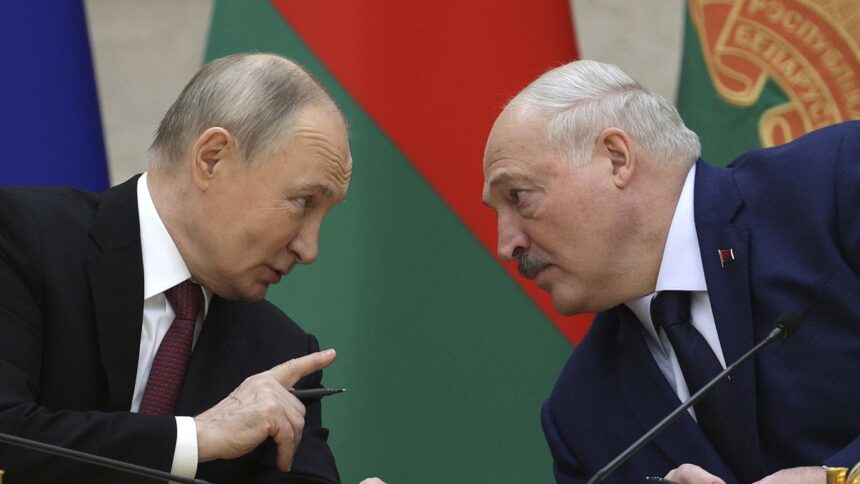The signing of the document during Putin’s visit to Minsk follows the publication of a revised version of Russia’s nuclear doctrine which for the first time placed Belarus under the Russian nuclear umbrella.
Russian President Vladimir Putin has signed a treaty offering security guarantees to Belarus, including the possible use of Russian nuclear weapons to help repel any aggression.
The signing of the document during Putin’s visit to Minsk follows the publication of a revised version of Russia’s nuclear doctrine which for the first time placed Belarus under the Russian nuclear umbrella amid the tensions between Moscow and the West over the war in Ukraine.
Speaking alongside Belarus’ President Alexander Lukashenko, Putin said the new document includes the potential use of Russian tactical nuclear weapons deployed to Belarus in response to an aggression.
“I’m sure that the treaty will ensure the security of Russia and Belarus,” Putin said in televised remarks.
After the two leaders signed the security pact, Lukashenko asked Putin to deploy more advanced weapons in Belarus, including the new ‘Oreshnik’ intermediate-range ballistic missile that Russia used for the first time last month in Ukraine.
“I would like to publicly ask you to deploy new weapons systems, primarily ‘Oreshnik’, to Belarus,” Lukashenko said.
“It will help calm some heads.”
Putin responded that Oreshnik missiles could be deployed to Belarus in the second half of next year, adding that they will remain under Russian control but Moscow will allow Belarus to select the targets.
The Russian president has described the 21 November strike on Ukraine with the ‘Oreshnik’ as a response to Ukrainian strikes on Russian military facilities in the Bryansk and Kursk regions with Western-supplied weapons.
He has warned that Russia could use the new missile to strike military facilities of Kyiv’s Western allies that allow Ukraine to use their weapons for attacks on Russian territory.
Putin has hailed the ‘Oreshnik’ missile’s capability, saying that its multiple warheads that plunge to a target at 10 times the speed of sound are immune to interception by any existing air defence systems.
Russia’s missile forces chief said the missile, which can carry conventional or nuclear warheads, has a range allowing it to reach all of Europe.
The revamped nuclear doctrine that Putin endorsed last month formally lowered the threshold for Russia’s use of its nuclear weapons, a move that follows US President Joe Biden’s policy shift to let Ukraine strike targets inside Russian territory with American-supplied longer-range missiles.
The doctrine says Moscow could use nuclear weapons “in response to the use of nuclear and other types of weapons of mass destruction” against Russia or its allies, as well as “in the event of aggression” against Russia and Belarus with conventional weapons that threaten “their sovereignty and/or territorial integrity.”
Putin and other Russian officials have repeatedly said that Russian tactical nuclear weapons deployed to Belarus remain under Moscow’s control, but the secretary of Belarus’ Security Council, Alexander Volfovich, said Friday that their use would require Lukashenko’s sanction.
Lukashenko, who has ruled Belarus for more than 30 years and has relied on Russian subsidies and support, allowed Russia to use his country’s territory to send troops into Ukraine in February 2022 and to deploy some of its tactical nuclear weapons in Belarus.
Belarus’ opposition leader-in-exile, Sviatlana Tsikhanouskaya, condemned the security pact between Russia and Belarus as part of Moscow’s efforts to tighten control over the country.
“Putin’s visit to Minsk isn’t about security, it’s about Russia tightening control over our country,” she said.
“The deployment of new weapons and using Belarus as a pawn in his imperial ambitions threatens us all.”










